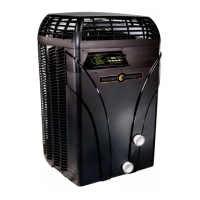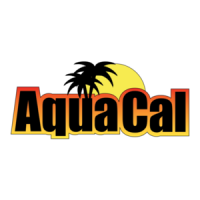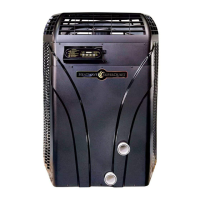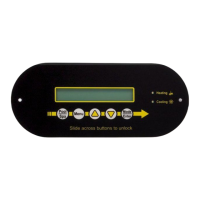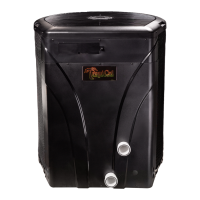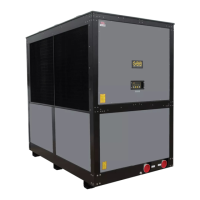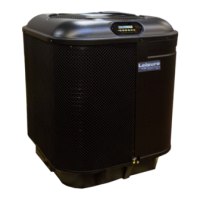Do you have a question about the Aquacal Heat Pump and is the answer not in the manual?
Patented titanium heat exchanger for superior water chemistry resistance.
Digitally-based controller for precise temperature control and diagnostics.
Quieter, more reliable compressor with fewer moving parts.
Durable ABS material for fade resistance and rust prevention.
Ability to heat or cool pool/spa water for year-round comfort.
Active defrost cycle for continuous operation in freezing weather.
Explains WARNING and CAUTION signal meanings for user safety.
Emphasizes that repairs must be done by qualified personnel.
Highlights the need for certified technicians for refrigerant circuit work.
Warns about hyperthermia risks from excessively hot water.
Addresses hazards of improper water chemistry and equipment damage.
Steps to ensure the unit has power before operation.
Instructions for setting pool/spa temperatures and modes.
Steps to initiate the heating process.
Guidance on filter pump operation for heat pump efficiency.
Explanation of normal condensation and its implications.
Preferred methods for safely shutting down the unit.
Diagram and identification of control panel components.
Explanation of buttons, lights, and the LED display functions.
Explains various codes displayed during operation or programming.
Initial power-up sequence and controller display.
Explanation of operating modes (OFF, HEAT, COOL, ACH).
Preferred methods for shutting down the unit.
How to switch between pool and spa temperature settings.
Steps to adjust the desired pool temperature.
Steps to adjust the desired spa temperature.
Procedure to switch between Fahrenheit and Celsius displays.
Explanation of the security feature to lock controls.
Procedure to disable the user lock code.
Recovery method if the lock code is forgotten.
Configuration for automatic pump run time adjustments.
Recommendations for professional annual inspection and basic upkeep.
Critical safety warnings when cleaning the unit.
Importance of filter and pump maintenance for adequate flow.
Recommended water chemistry standards for pool/spa.
Warning regarding water flow during refinishing or acid cleaning.
Protecting the unit from water damage from external sources.
Requirements for airflow and service access.
Tips for optimizing heating during colder periods.
Benefits and safety warnings for using pool blankets.
How to heat both pool and spa, with automation options.
Optimizing spa heating and using setback temperatures.
Recommendations for operation during the swimming season.
Critical information for protecting the heater in freezing conditions.
Warnings and initial steps for winterizing.
Diagnosing why the unit is not starting or running.
Troubleshooting when the unit runs but doesn't heat effectively.
Distinguishing between normal condensation and leaks.
Visual guide to diagnose and resolve failure to operate issues.
Visual guide for diagnosing heating performance problems.
Flowchart for identifying water leaks or condensation.
Guide to understanding the model and specification data plate.
Dimensional drawings and specifications for models 035, 055, & 075.
Dimensional drawings and specifications for models 110 & 120.
Dimensional drawings and specifications for model SQ121.
Dimensional drawings and specifications for models 135, 155, & 175.
Dimensional drawings and specifications for model SQ156.
Discouraged but detailed guidance for indoor installations.
Requirements for service and operational clearances outdoors.
Compliance with local, state, and national spacing requirements.
Protecting the unit from water damage from external sources.
Specifications for constructing a suitable mounting pad.
Procedures for securing the unit against wind loads.
Guide to plumbing schematics and flow rate requirements.
Standards for materials and installation methods.
Recommendations for placement of chlorinators.
Importance of unions for easy winterization.
Details on supplied PVC unions and connection methods.
Specifies maximum pressure and required flow rates.
Advisories for systems prone to water hammer.
Illustrates typical water inlet and outlet connections.
Guidelines for locating disconnects and sizing wiring.
Compliance with NEC and local electrical codes.
Information on integrating external control systems.
Using the data plate to determine service requirements.
AquaCal's recommendation regarding GFCI protection.
Overview of advanced settings for specific site characteristics.
Steps to access the service menu for programming.
Setting or deactivating the 4-minute start-up delay.
Steps to configure for external controls or flow switches.
Procedure to verify and adjust water temperature sensor readings.
How to check and adjust the defrost sensor accuracy.
Setting the temperature range for spa heating/cooling activation.
Setting the temperature range for pool heating/cooling activation.
Managing service lock codes and back-door entry.
Purpose and function of the mode jumper.
Steps to check if the jumper is set correctly.
Procedure to change the jumper position if incorrect.
How defrost operates on heat-only models.
How active hot gas defrost works on heat/cool models.
Step-by-step sequence of the heat/cool defrost operation.
How to find and identify the pressure switch.
Adjustment procedure for Len Gordon brand switches.
Adjustment procedure for TecMark brand switches.
Final checks and reassembly after adjustment.
Essential information to have ready before calling for support.

